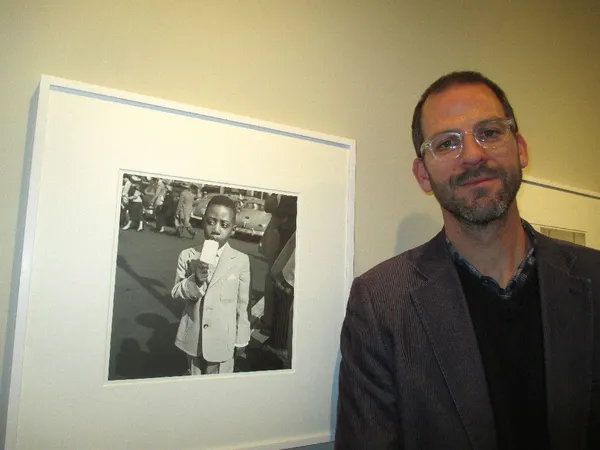 |
| Finding Vivian Maier co-director Charlie Siskel: "I think that Vivian had in mind an audience for her work, that some day people would see it." Photo: Anne-Katrin Titze |
Finding Vivian Maier directors Charlie Siskel and John Maloof at a reception for Vivian Maier: In Her Own Hands at the Howard Greenberg Gallery gave me a tour of the exhibition. There are more than 40 Maier photographs including Lena Horne in 1954, marvelous cityscapes, and people whose thoughts can be felt in the twist of a shapely leg. Emily Dickinson, Franz Kafka, Henry Darger and Pippi Longstocking entered into our conversations.
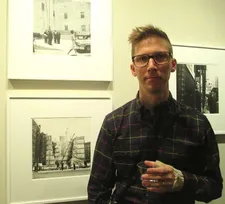 |
| Finding Vivian Maier co-director John Maloof: "In this one with the building being demolished you can see the beautiful gothic architecture behind it." Photo: Anne-Katrin Titze |
Vivian Maier: A Photographer Found with a foreword by Laura Lippman - writer for Amy Berg's Every Secret Thing - and a text by Marvin Heiferman accompanies the impressive exhibition.
The film was screened in the DOC NYC Short List program last month and has now joined the Oscar shortlist as one of 15 documentaries out of 134 submissions. The final cut down to five nominations will be announced on January 15, 2015 for the 87th Academy Awards to be held on February 22, 2015.
Finding Vivian Maier traces Maloof's steps from bidding at an auction that turned into the discovery of superb, wide-ranging work of an unknown photographer and on to the journey of wanting to know who that woman with the Rolleiflex, frequent tweed suits and exemplary eye actually was.
Anne-Katrin Titze: This is a very interesting selection of photographs. You said you have seen some of them here for the first time?
Charlie Siskel: Yes, some of these I've seen for the first time. Let me give you a tour.
We are standing next to a photo from 1956, showing the back of a woman in a red dress with white dots and an embroidered daisy double belt waist. Her hands give away her thoughts.
AKT: This one is beautiful.
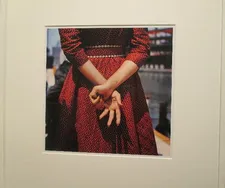 |
| Woman in a red dress with white dots - Vivian Maier: "I think it's incredible to see the color images." |
Siskel: They are all beautiful and I think it's incredible to see the color images. Obviously, there is an element of nostalgia in all of Vivian's work. We are finding a time capsule. Her work on the street represents decades. Women's fashion and architecture and street life in New York City and Chicago from the 50s, 60s and 70s. There is an element of historical importance to all of her work.
AKT: Over there is a photo of a little girl, or boy, on a bench, that could have been taken yesterday.
Siskel: Absolutely. Because Vivian is interested in many different subjects not just a photographer of street life. Although she did take photographs of urban crime at night that looks like the works of Weegee, she is also keenly interested in the inner lives of children. There are so many images of children in relationship to the adult world.
AKT: Also, the way she captures female body language. The photo of Lena Horne and next to it the photo of two women. There is something very specific that she captured in the way they stand.
Siskel: Her ability to get the moment. Vivian, typically, would not take multiple exposures. This happens to be a vintage print. Vivian printed this [the photo of the two women on the street]. She didn't print a lot of her work. When we have contact sheets of her work, we would find an image like that and then Vivian turns around and walks up the street and she is shooting something entirely different. She would capture a moment, realise that she had something and move on.
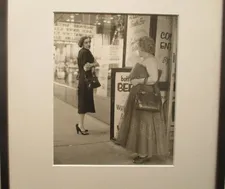 |
| Two women - Vivian Maier: "This happens to be a vintage print. Vivian printed this." |
AKT: And the Lena Horne picture? There aren't many photos of famous people.
Siskel: There are a number of famous people. We debated whether to include that in the film or not. I wonder if we should have tried harder to find a place for it in the film. Vivian would show up at press events or red carpets.
AKT: Like this?
Siskel: Like this. And Vivian would be there with her camera but she wasn't working for a newspaper. She was just doing it for herself.
AKT: She was doing it for you.
Siskel: For all of us.
AKT: For the future.
Siskel: I really do believe that. Vivian didn't show during her lifetime and there are many reasons for that. Many artists don't show their work. It's intimidating, they risk rejection, it's expensive in the case of photography, the prints, etc.
AKT: And the opportunities, too. Where would she show them?
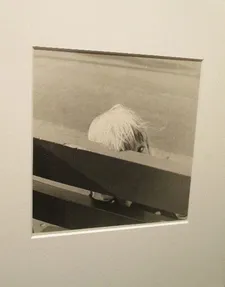 |
| On a bench - Vivian Maier: "She is also keenly interested in the inner lives of children." |
Siskel: She couldn't snap her fingers and go from being a nanny to being a photographer. But the one thing is that she never let it stop her from doing the work. I think that Vivian had in mind an audience for her work, that some day people would see it. And I think we are that audience.
She meticulously preserved her work. She didn't destroy it, she did the opposite. It cost her a lot of time and money and effort to preserve the work the way she did.
You know, Kafka and Emily Dickinson, they told people to destroy their work and thankfully people didn't do that. I think Vivian finally is getting the audience, not only that she deserves, but that she really wanted. I think she knew she was a great artist.
AKT: There were moments in the film when I thought of people like Henry Darger, but then I quickly moved on from that. Her work does not shout 'obsession'.
Siskel: I think it does disservice to Vivian Maier to make that comparison. When you look at her work and look at her life. This is the work and life of a true artist. That's who Vivian Maier really was. She wasn't taking pictures as a kind of therapy, to work out her demons. She is interested in women's fashion. She is interested in observing human behavior. She was not a recluse, she was out in the world and engaged with people and approaching people. In other cases she would take photos surreptitiously.
She wasn't hiding her work away to keep a catalogue of her inner fantasies. I don't know if that's a good description of Henry Darger, but the comparison is to say that there is this strange "outsider artist". Vivian Maier to me is not an outsider artist. She's an artist creating work in a tradition. She was fully aware of what other artists were doing. She was a moviegoer, she went to museums, she collected books. Her work belongs in the canon of great 20th century photographers.
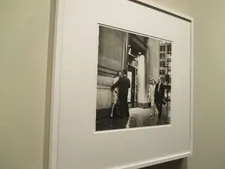 |
| A man and a woman arguing - Vivian Maier: "She would capture a moment, realie that she had something and move on." |
The only difference is that Vivian never had access to that world. Because of her circumstances - being a woman in the Fifties and Sixties, lacking the means and therefore having to work in a servant industry job, working as domestic help, she needed that to make ends meet.
AKT: I am glad that you explained where parallels to Darger or other "outsider art" fall short and shouldn't be an end point. The discussion about opportunities and different paths for artists is, I think, something very right to do in this context.
Siskel: She never let it deter her. Not only does she have a brilliant eye, she has the persistence of an artist who will do it no matter what.
AKT: Please pick a photograph in the exhibition you would like to pose next to so that I can take a picture of you.
Siskel: How about that one right there with the boy and the ice cream?
AKT: Why that one?
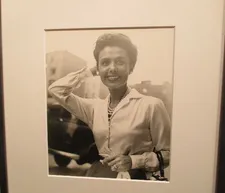 |
| Lena Horne - Vivian Maier: "Vivian would show up at press events or red carpets." |
Siskel: Oh, I think it shows Vivian's particular empathy and sensitivity to children and their inner lives. It also is a beautiful image of the boy. His brow is furrowed. He is contemplating something and looks very handsome in his suit.
AKT: And you like ice cream?
Siskel: And I like ice cream!
Next, I asked John Maloof if he had a particular favorite in the exhibition. He walked to one with two couples on the street. My eye again is first drawn to a woman's limbs, as so often in Maier's work. In this case it is a leg.
John Maloof: It's interesting that she's documenting a man and a woman arguing in the street. It's kind of like a man and a woman fighting and there's another man and woman walking and they're kind of like oblivious.
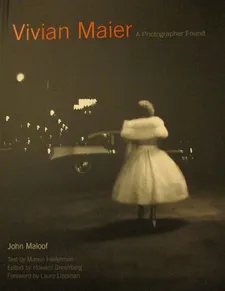 |
| Vivian Maier: A Photographer Found excellent comprehensive monograph with a foreword by Laura Lippman |
AKT: She has a fantastic eye for split second female body language that is very telling. It's a moment of recognition in the position of the leg in this one. In the photo over there it is how the woman in black is leaning back for a second.
Maloof: That's what street photography captures when you get a fast shutter speed, there'll always be a quick slice of what's going on. But she does a lot of different stuff. There's decisive moments and there's a more slower approach to photography. In this one with the building being demolished you can see the beautiful gothic architecture behind it.
The composition is kind of great, people spread out. It means something to whoever wants to put meaning to it. My own perspective of photography - you see a scene and you don't have enough time to think of what it means, you take the photo, and then you see meaning in it after you look at the image. Certain things draw you to certain things and that's meaningful too. Why is she taking a photo of a building being demolished or a woman fighting?
AKT: Once you purchased the finding, was there a first photo that made you aware of what a treasure you unearthed?
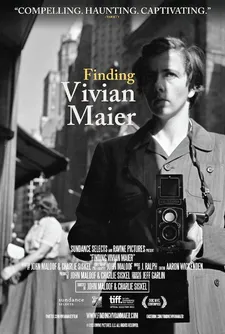 |
| Finding Vivian Maier poster |
Maloof: I don't remember. It wasn't important at the time. I didn't buy it because I thought it was good. I didn't know it was good. I have no idea. There was no eureka moment with this discovery. It was a long time to realise that it was good. You can't just take a pack of images, look up into the light and say, 'Oh, my god, everything in this box is going to be fantastic.' Because for most photographers, every photographer, most of their work is bad, really. There's a small amount of good work. To find these key pieces in there takes a long time.
AKT: Are you familiar with Pippi Longstocking?
Maloof: Yeah.
AKT: Pippi describes herself as a "thing-searcher", great finder of things. You are in that tradition. I hope you're not offended, it's a compliment.
Maloof [laughs]: Whatever.
Vivian Maier: In Her Own Hands is on exhibit through December 6, 2014 at the Howard Greenberg Gallery 41 East 57th Street, Suite 1406, New York City.





















